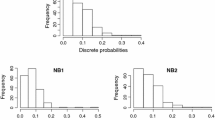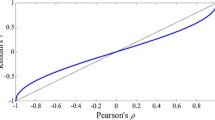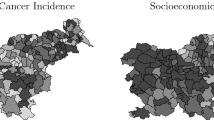Abstract
The present paper reports on the use of copula functions to describe the distribution of discrete spatial data, e.g. count data from environmental mapping or areal data analysis. In particular, we consider approaches to parameter point estimation and propose a fast method to perform approximate spatial prediction in copula-based spatial models with discrete marginal distributions. We assess the goodness of the resulting parameter estimates and predictors under different spatial settings and guide the analyst on which approach to apply for the data at hand. Finally, we illustrate the methodology by analyzing the well-known Lansing Woods data set. Software that implements the methods proposed in this paper is freely available in Matlab language on the author’s website.





Similar content being viewed by others
References
Bárdossy A (2006) Copula-based geostatistical models for groundwater quality parameters. Water Resour Res 42:W11416
Bárdossy A, Li J (2008) Geostatistical interpolation using copulas. Water Resour Res 44:W07412
Bhat C, Sener P, Eluru N (2010) A flexible spatially dependent discrete choice model: formulation and application to teenagers weekday recreational activity participation. Transp Res B 44:903–921
Breslow N, Clayton D (1993) Approximate inference in generalized linear mixed models. J Am Stat Assoc 88:9–25
Diggle P, Tawn J, Moyeed R (1998) Model-based geostatistics (with discussion). Appl Stat 47:299–350
Diggle P, Ribeiro P (2007) Model-based geostatistics. Springer, New York
Famoye F, Singh K (2003) On inflated generalized Poisson regression models. Adv Appl Stat 3(2):145–158
Fingleton B (1986) Analyzing cross-classified data with inherent spatial dependence. Geogr Anal 18:4861
Gelman A, Rubin D (1992) Inference from iterative simulation using multiple sequences (with discussion). Stat Sci 7:457–511
Goovaerts P (2001) Geostatistical modelling of uncertainty in soil science. Geoderma 103:3–26
Heagerty P, Lele S (1998) A composite likelihood approach to binary spatial data. J Am Stat Assoc 93:1099–1111
Hjort N, Omre H (1994) Topics in spatial statistics. Scand J Stat 21:289–358
Joe H (1997) Multivariate models and dependence concepts. Chapman & Hall/CRC, Boca Raton
Kazianka H (2012) spatialCopula: a Matlab toolbox for copula-based spatial analysis. Stoch Environ Res Risk Assess. doi:10.1007/s00477-012-0571-3 (in press)
Kazianka H, Pilz J (2010) Spatial interpolation using copula-based geostatistical models. In: Atkinson P, Lloyd C (eds) geoENV VII: geostatistics for environmental applications. Springer, Berlin, pp 307–320
Kazianka H, Pilz J (2010) Copula-based geostatistical modeling of continuous and discrete data including covariates. Stoch Environ Res Risk Assess 24:661–673
Kazianka H, Pilz J (2011) Bayesian spatial modeling and interpolation using copulas. Comp Geosci 37:310–319
Kazianka H, Pilz J (2012) Objective Bayesian analysis of spatial data with uncertain nugget and range parameters. Can J Stat 40:304–327
Li J, Bárdossy A, Guenni L, Liu M (2011) A copula based observation network design approach. Environ Model Softw 26:1349–1357
Lin P-S, Clayton M (2005) Analysis of binary spatial data by quasi-likelihood estimating equations. Ann Stat 33:542–555
Madsen L. (2009) Maximum likelihood estimation of regression parameters with spatially dependent discrete data. J Agric Biol Environ Stat 14:375–391
Pflug G, Römisch W (2008) Modeling, measuring and managing risk. World Scientific, London
Robert C, Casella G (2004) Monte Carlo statistical methods. Springer, New York
Rüschendorf L (2009) On the distributional transform, Sklar’s theorem, and the empirical copula process. J Stat Plann Inference 139:3921–3927
Sener I, Bhat C (2012) Flexible spatial dependence structures for unordered multinomial choice models: formulation and application to teenagers’ activity participation. Transp Policy 39:657–683
Sklar A (1959) Fonctions de repartition a n dimensions et leurs marges. Publ Inst Stat Univ Paris 8:229–231
Stein M (1999) Interpolation of spatial data: some theory for kriging. Springer, New York
Varin C (2008) On composite marginal likelihoods. AStA Adv Stat Anal 92:1–28
Author information
Authors and Affiliations
Corresponding author
Rights and permissions
About this article
Cite this article
Kazianka, H. Approximate copula-based estimation and prediction of discrete spatial data. Stoch Environ Res Risk Assess 27, 2015–2026 (2013). https://doi.org/10.1007/s00477-013-0737-7
Published:
Issue Date:
DOI: https://doi.org/10.1007/s00477-013-0737-7




